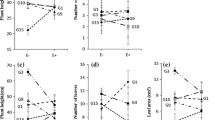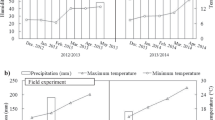Abstract
Livestock grazing endophyte-infected tall fescue (Festuca arundinacea Schreb.) pastures often suffer from ergot poisoning. The endophyte,Neotyphodium coenophialum (Morgan-Jones and Gams) Glenn, Bacon, and Hanlin, comb. nov., also provides drought-tolerant, insect-resistant, and disease-resistant qualities to the plant. Therefore, producers are faced with a biological dilemma of risking loss of pasture by using endophyte-free tall fescue pasture or animal losses with endophyte-infected tall fescue pasture. One potential solution is to breed endophyte-infected tall fescue with lower levels of alkaloids. However, breeding could select for plants that are antagonistic to the endophyte, resulting in reduced plant vigor as a consequence of disruption of the mutualistic association between the organisms. The objectives of this study were to determine the relationship between plant mass and endophyte mycelial proteins versus ergot alkaloid concentration. To examine the endophyte effect on mycelial mass, tissue culture regenerants from tall fescue genotype PDN2 were infected with endophyte isolates EDN11, EDN12, and EDN2 to eliminate confounding effects of multiple plant genotypes. Crosses with PDN11 as the maternal parent and plant genotypes DN2, DN12, and DN15 as paternal parents were used to produce a population of different plant genotypes, all containing the same endophyte. Fungal mycelial protein was extracted from lyophilized tall fescue leaf sheath tissue and immunochemically quantified with monoclonal antibodies specific toN. coenophialum proteins. Ergot alkaloid concentration was also immunochemically measured. Quantities of mycelial protein and ergot alkaloids were calculated by regressing experimental values against standards of each. There was no correlation between herbage mass and alkaloid concentration or fungal protein quantity and alkaloid concentration when different fungal isolates were inserted into the same plant genotype. Coefficients of determination (r 2) were low (0.31 and 0.17) between leaf sheath and leaf blade alkaloid concentrations and endophyte protein when different plant genotypes contained the same endophyte isolate. Likewise,r 2 values were low between leaf sheath and leaf blade alkaloid concentrations and herbage mass. These data suggest that little or no antagonism occurred to the endophyte among plants low in alkaloid concentration.
Similar content being viewed by others
REFERENCES
ADCOCK, R. A., HILL, N. S., BOUTON, J. H., BOERMA, H. R., and WARE, G. O. 1997. Symbiont regulation and reducing ergot alkaloid concentration by breeding endophyte-infected tall fescue.J. Chem. Ecol. 23:691–704.
AGEE, C. S., and HILL, N. S. 1994. Ergovaline variability inAcremonuium-infected tall fescue due to environment and plant genotype.Crop Sci. 34:221–226.
ARACHEVALETA, M., BACON, C. W., HOVELAND, C. S., and RADCLIFFE, D. E. 1989. Effect of the tall fescue endophyte on plant response to environmental stress.Agron. J. 81:83–90.
BACON, C. W., and SIEGEL, M. R. 1988. Endophyte parasitism of tall fescue.J. Prod. Agric. 1:45–55.
BERMINGHAM, S., DEWEY, F. M., and MALTBY, L. 1995. Development of a monoclonal antibody-based immunoassay for the detection and quantification ofAnguillospora longissima colonizing leaf material.Appl. Environ. Microbiol. 61:2606–2613.
BERMINGHAM, S., MALTBY, L., and DEWEY, F. M. 1996. Monoclonal antibodies as tools to quantify mycelium of aquatic hyphomycetes.New Phytol. 132:593–601.
BOUTON, J. H., GATES, R. N., BELESKY, D. P., and OWSLEY, M. 1993. Yield and persistence of tall fescue in the southeastern coastal plain after removal of its endophyte.Agron. J. 85:52–55.
CHRISTENSEN, M. J. 1995. Variation in the ability ofAcremonium endophytes ofLolium perenne, Festuca arundinacea, andF. pratensis to form compatible associations in the three grasses.Mycol. Res. 99:466–470.
CLARK, E. M., WHITE, J. F., and PATTERSON, R. M. 1983. Improved histochemical techniques for the detection ofAcremonium coenophialum in tall fescue and methods ofin vitro culture of the fungus.J. Microbiol. Methods 1:149–155.
CRESS, W. A., CHAYET, L. T., and RILLING, H. C. 1981. Crystallization and partial characterization of dimethyallyl pyrophasphate: L-Tryptophan dimethyallyl transferase fromClaviceps sp. SD58.J. Chem. 256:10917–10923.
DAVIES, E., LANE, G. A., LATCH, G. C. M., TAPPER, I., GARTHWAITE, N. R., FLETCHER, L. R., and POWNALL, D. B. 1993. Alkaloid concentrations in field-grown synthetic perennial ryegrass endophyte associations, p. 72,in D. E. Hume, G. C. M. Latch, and H. S. Easton (eds.). Proceedings of the Second International Symposium onAcremonium/Grass Interactions, February 3–6, Palmerstown North, New Zealand. AgResearch Grasslands, Palmerstown North.
DAY, P. R. 1974. Genetics of Host-Parasite Interaction. W. H. Freeman, San Francisco.
FLETCHER, L. R., and SUTHERLAND, B. L. 1993. Liveweight change in lambs grazing perennial ryegrasses with different endophytes, pp. 125–127,in D. E. Hume, G. C. M. Latch, and H. S. Easton (eds.). Proceedings of the Second International Symposium onAcremonium/Grass Interactions, February 3–6, Palmerstown North, New Zealand. AgResearch Grasslands, Palmerstown North.
HIATT, E. E., III, HILL, N. S., BOUTON, J. H., and MIMS, C. W. 1997. Monoclonal antibodies for detection ofNeotyphodium coenophialum.Crop Sci. 37:265–1269.
HILL, N. S. 1995. Progress report—The University of Georgia, pp. 14–16,in F. T. Withers (ed.). Proceedings of the Tall Fescue Workshop, November 13–15, Nashville. The Southern Extension and Research Activity Information Exchange Group 8, Mississippi Agricultural and Forestry Experiment Station, Mississippi State, Mississippi.
HILL, N. S., and AGEE, C. S. 1994. Detection of ergoline alkaloids in endophyte-infected tall fescue by immunoassay.Crop Sci. 34:530–534.
HILL, N. S., BELESKY, D. P., and STRINGER, W. C. 1991a. Competitiveness of tall fescue as influenced byAcremonium coenophialum.Crop Sci. 31:185–190.
HILL, N. S., PARROTT, W. A., and POPE, D. D. 1991b. Ergopeptine alkaloid production by endophytes in a common fescue genotype.Crop Sci. 31:1545–1547.
HILL, N. S., THOMPSON, F. N., DAWE, D. L., and STUEDEMAN, J. A. 1994. Antibody binding of circulating ergot alkaloids in cattle grazing tall fescue.Am. J. Vet. Res. 55:419–424.
HILL, N. S., PACHON, J. G., and BACON, C. W. 1996.Acremonium coenophialum-mediated short-and long-term drought acclimation in tall fescue.Crop Sci. 36:665–672.
HOOKER, A. L. 1983. Breeding to control pests, pp. 199–230,in D. R. Wood, K. M. Rawal, and M. N. Wood (eds.). Crop Breeding. American Society of Agronomy, Madison, Wisconsin.
KEARNEY, J. F., PARROTT, W. A., and HILL, N. S. 1991. Infection of somatic embryos of tall fescue withAcremonium coenophialum.Crop Sci. 31:979–984.
KENAGA, C. B. 1974. Principles of Phytopathology. Balt Publishers, Lafayette, Indiana.
LAW, R. 1985. Evolution in a mutualistic environment, pp. 145–170,in D. H. Boucher (ed.). The Biology of Mutualism: Ecology and Evolution. Croom Helm, London.
LEE, S. L., FLOSS, H. G., and HEINSTEIN, P. 1976. Purification and properties of dimethylallyl-pyrophosphate: Tryptophan dimethylallyl tryptophan transferase, the first enzyme of ergot alkaloid biosynthesis inClaviceps sp. SD58.Arch. Biochem. Biophys. 177:84–94.
ROYLANCE, J. T., HILL, N. S., and AGEE, C. S. 1994a. Ergovaline and paramine production in endophyte-infected tall fescue: Independent regulation and effects of plant and endophyte genotype.J. Chem. Ecol. 20:2171–2183.
ROYLANCE, J. T., HILL, N. S., and PARROTT, W. A. 1994b. Detection of somoclonal variation in tissue culture regenerants of tall fescue.Crop Sci. 34:1369–1372.
RUSSEL, G. E. 1978. Plant Breeding for Disease Resistance. Butterworths, London.
SIEGEL, M. R., and LATCH, G. C. 1991. Expression of antifungal activity in agar culture by isolates of grass endophyte.Mycologia 83:529–537.
SIEGEL, M. R., LATCH, G. C., BUSH, L. P., FANNIN, F. F., ROWAN, D. D., TAPPER, B. A., BACON, C. W., and JOHNSON, M. C. 1990. Fungal endophyte-infected grasses: Alkaloid accumulation and aphid response.J. Chem. Ecol. 16:3301–3315.
SLEPER, D. A. 1979. Plant breeding, selection, and species in relation to grass tetany, pp. 63–78,in V. V. Rendig and D. L. Grunes (eds.). Grass Tetany. American Society of Agronomy, Crop Science Society of America, and Soil Science Society of America, Madison, Wisconsin.
STUEDEMANN, J. A., and HOVELAND, C. S. 1988. Fescue endophyte: History and impact on animal agriculture.J. Prod. Agric. 1:39–44.
WEST, C. P., IZEKER, E., OOSTERHUIS, D. M., and ROBBINS, R. T. 1988. The effect ofAcremonium coenophialum on the growth and nematode infestation of tall fescue.Plant Soil 112:3–6.
Author information
Authors and Affiliations
Rights and permissions
About this article
Cite this article
Hiatt, E.E., Hill, N.S. Neotyphodium coenophialum Mycelial Protein and Herbage Mass Effects on Ergot Alkaloid Concentration in Tall Fescue. J Chem Ecol 23, 2721–2736 (1997). https://doi.org/10.1023/A:1022558909690
Issue Date:
DOI: https://doi.org/10.1023/A:1022558909690




